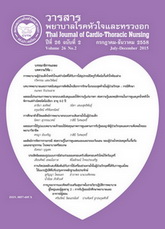ผลของการใช้รูปแบบพยาบาลเจ้าของไข้ต่อคุณภาพการดูแลตามการรับรู้ของญาติผู้ป่วยวิกฤตและความพึงพอใจของพยาบาลวิชาชีพ
Keywords:
รูปแบบพยาบาลเจ้าของไข้, การดูแลผู้ป่วยภาวะวิกฤต, คุณภาพการดูแล, ความพึงพอใจของพยาบาล, primary nursing care model, critical care nursing, quality of care, nurses’ satisfactionsAbstract
การวิจัยนี้เป็นการวิจัยกึ่งทดลอง มีวัตถุประสงค์เพื่อทดสอบประสิทธิผลของคุณภาพการดูแลโดยใช้รูปแบบการพยาบาลเจ้าของไข้ และเปรียบเทียบความพึงพอใจของพยาบาลวิชาชีพระหว่างการพยาบาลปกติ และการใช้รูปแบบการพยาบาลเจ้าของไข้ กลุ่มตัวอย่างได้แก่ ญาติของผู้ป่วยวิกฤตจำนวน 40 คนที่ได้รับการรักษาในหน่วยวิกฤต แบ่งเป็นกลุ่มควบคุม 20 คน และกลุ่มทดลอง 20 คน ได้รับการคัดเลือกโดยการจับคู่ เพศ อายุ กลุ่มโรค APACHE II score ของผู้ป่วยเป็นตัวกำหนด กลุ่มทดลองได้รับการดูแลโดยใช้รูปแบบพยาบาลเจ้าของไข้ กลุ่มควบคุมได้รับการดูแลตามปกติ นอกจากนี้คัดเลือกกลุ่มตัวอย่างพยาบาลวิชาชีพหอผู้ป่วยวิกฤต จำนวน 20 คนแบบเจาะจงตามคุณสมบัติที่กำหนด เครื่องมือที่ใช้ในการทดลอง คือรูปแบบพยาบาลเจ้าของไข้ ในหอผู้ป่วยวิกฤต ประกอบด้วยคู่มือพยาบาลเจ้าของไข้สำหรับพยาบาลหอผู้ป่วยวิกฤตอายุรกรรมซึ่งสร้างและพัฒนาโดยผู้วิจัย เครื่องมือที่ใช้ในการเก็บรวบรวมข้อมูล ได้แก่ 1) แบบสอบถามคุณภาพการดูแลตามการรับรู้ของญาติผู้ป่วยวิกฤตและ 2) แบบสอบถามความพึงพอใจของพยาบาลวิชาชีพ วิเคราะห์ข้อมูลโดยสถิติเชิงบรรยาย และสถิติทดสอบที
ผลการวิจัยพบว่า คุณภาพการดูแลตามรับรู้ของญาติผู้ป่วยวิกฤตอายุรกรรมโดยรวมทุกด้านจากการใช้รูปแบบพยาบาลเจ้าของไข้สูงกว่าการพยาบาลปกติ อย่างมีนัยสำคัญทางสถิติที่ระดับ .05 และความพึงพอใจของพยาบาลวิชาชีพหอผู้ป่วยวิกฤตอายุรกรรมโดยรวมทุกด้าน หลังใช้รูปแบบพยาบาลเจ้าของไข้สูงกว่าการพยาบาลปกติอย่างมีนัยสำคัญที่ระดับ .05
ผลการวิจัยนี้สามารถนำไปประยุกต์ใช้ในสถานบริการสุขภาพเพื่อเป็นแนวทางในการจัดรูปแบบพยาบาลเจ้าของไข้ในหอผู้ป่วยวิกฤตอื่นๆ เช่น หอผู้ป่วยวิกฤตศัลยกรรม หอผู้ป่วยวิกฤตกุมารให้ได้รับคุณภาพการดูแลเพิ่มขึ้น
Effects of a primary nursing model on quality of care as perceived by relatives of critical ill patients and
nurses’ satisfactions
The purposes of this quasi-experimental research were to determine the effectiveness of the quality of care using primary nursing perceived by relatives and to compare nurse’s satisfactions between using usual nursing care and using primary nursing for medical intensive patients. The samples were 40 relatives of medical intensive patients receiving care at intensive care unit. They were divided into two groups, experimental group (n=20) and control group (n=20). Both groups were matched with respect to sex, age, diagnosis and APACHE II score. In addition, 20 intensive nurses were selected by purposive sampling. The research instruments were consisted of program of primary nursing model for medical intensive care units and primary nursing handbook. The data were obtained by questionnaires of quality of care perceived by relatives and questionnaire of nurses’ satisfactions. The data were analyzed using descriptive statistic and t-test.
The result of this study revealed that quality of care perceived by relatives using primary nursing model at medical intensive care units was significantly higher than those using usual nursing care (p< .05). In addition, nurses’ satisfactions in using primary nursing model, were significantly higher than those who used usual nursing care (p< .05).
The findings of this study can be applied in health care settings in order to apply primary nursing model as practical guidelines at other intensive care such as surgery intensive care unit, and pediatric intensive care unit to enhance higher quality of care and nurses’ satisfactions.
Downloads
How to Cite
Issue
Section
License
บทความนี้ยังไม่เคยตีพิมพ์หรืออยู่ในระหว่างส่งไปตีพิมพ์ในวารสารอื่น ๆ มาก่อน และกองบรรณาธิการขอสงวนสิทธิ์ในการตรวจทาน และแก้ไขต้นฉบับตามเกณฑ์ของวารสาร ในกรณีที่เรื่องของท่านได้ได้รับการตีพิมพ์ในวารสารฉบับนี้ถือว่าเป็น ลิขสิทธิ์ของวารสารพยาบาลโรคหัวใจและทรวงอก






